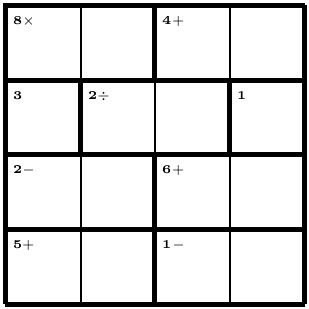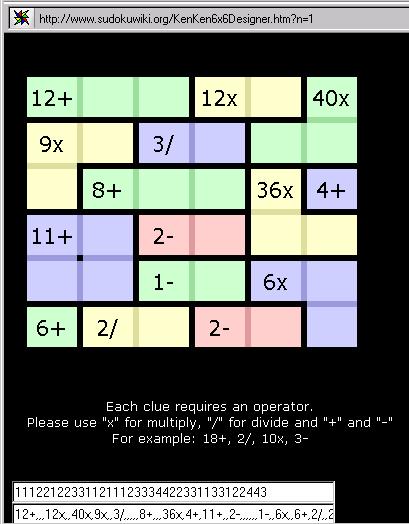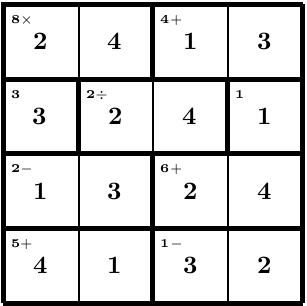KenKen® Puzzle Challenges
Contents |
KenKen is a popular number puzzle that appears in newspapers and web sites. Here's a sample puzzle.
(KenKen® is a registered trademark of Nextoy, LLC.)
Below are several challenges. Try the first one, and if you are adventurous try the more difficult ones. Submitted solutions will be published in the next issue. Send solutions to challenges 2, 3, and 4 to the editors.
Challenge 1 (Easy)
If you do not know how to solve a KenKen puzzle, try to solve the sample one shown here.
Rules:
- Fill in with the numbers 1–4.
- Do not repeat a number in any row or column.
- The numbers in each heavily outlined set of squares, called cages, must combine (in any order) to produce the target number in the top corner of the cage using the mathematical operation indicated.
- Cages with just one box should be filled in with the target number in the top corner.
- A number can be repeated within a cage as long as it is not in the same row or column.
For example, in the puzzle above, you can immediately fill in the squares with 1 and 3 in the second row. Now look at the cage in the upper right corner labeled 4+. The only way to make 4 is 3 + 1. (2 + 2 doesn't work because you are repeating a digit in the row.) The correct answer is 1 and 3 (it can't be 3 and 1 because the 1 would duplicate the 1 already in the fourth column). Try to solve the whole puzzle before looking at the solution below.
See kenken.com for more about how to solve the puzzles.
Once you have the hang of it, try some of the puzzles at kenken.com, CalcuDoku, New York Times and other sites. There are 4x4, 5x5, 6x6, ..., 9x9 puzzles as well.
Challenge 2 (Difficult)
Make a LaTeX or TeX file that will typeset the KenKen puzzle shown above.
Challenge 3 (Very difficult)
Make a LaTeX or TeX file that will create a simple KenKen puzzle from a puzzle-descriptor file.
A note on puzzle-descriptor file format: there are several sites on the web with KenKen puzzles, and at some point the puzzles are described in a file.
One site uses the file format shown in the image below. It consists of two parts: the first is the shape of the cages, and the second part is the cage labels. The shape of the cages is given as a map coloring, with colors 1 through 4. For an n x n puzzle there are n x n numbers, each giving the "color" of the current cage. The cage labels are in a comma-separated list, and there are n x n of these.
When solving this challenge, provide notes on the file format you use.
Challenge 4 (Insanely difficult)
Make a LaTeX or TeX file that will solve a simple KenKen puzzle given in a puzzle-descriptor file. See the previous challenge for file formats.
A similar puzzle distraction
See Sudoku solvers







